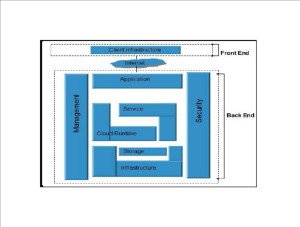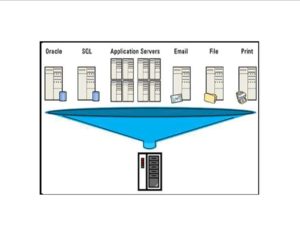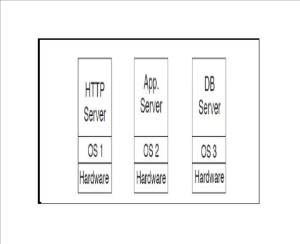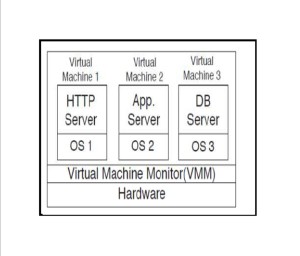– To study various issues to understand effectiveness of existing Quality of Service (QoS) controls on resource usage and thereby application performance.
– The goal is to consolidate the Data Center and increase its performance.
Conclusion
Server virtualization is always necessary for optimizing the IT Infrastructure. In this paper we have described about the architecture and several metrics (parameters) in evaluating the performance of Server Virtualization. This technology will become increasingly important in the future and be introduced for widespread as a common technology for building the IT infrastructure.
References
1. Abirami S.P. and Shalini Ramanathan (2012), ‘Linear Scheduling Strategy for Resource Allocation in Cloud Environment ‘, International Journal on Cloud Computing: Services and Architecture (IJCCSA), Vol.2, No.1, February 2012.
2. Andrew J. Younge, Robert Henschel, James T. Brown, Gregor von Laszewski, Judy Qiu, Geoffrey C. Fox(2011), ‘Analysis of Virtualization Technologies for High Performance Computing Environments’, Pervasive Technology Institute, Indiana University 2729 E 10th St., Bloomington, IN 47408, U.S.A. {ajyounge,henschel,jatbrown,gvonlasz,xqiu,gcf}@indiana.edu, Proceedings of the IEEE 4th International Conference on Cloud Computing (CLOUD), 9-16.
3. Andrea Arcangeli, Izik Eidus and Chris Wright,‘ Increasing memory density by using KSM”, Red Hat, Inc. aarcange@redhat.com, ieidus@redhat.com, chrisw@redhat.com.
4. Anton Beloglazov, Jemal Abawajy, Rajkumar Buyya (2012),’ Energy—aware resource allocation heuristics for efficient management of Data Centers for Cloud Computing ‘,Future Generation Computer Systems, Elsevier, also available at Science Direct, Sponsored by Cloud Computing and Distributed Systems(CLOUDS)’.
5. ‘Application Performance Management in a Virtualized Environment Growing “, WHITE PAPER: APPLICATION PERFORMANCE MANAGEMENT.
6. Aravind Menon, Jose Renato, Yoshio Turner,G. (John) Janakiraman, Palo Alto john,Willy and Zwaenepoel(2005), ‘ Diagnosing Performance Overheads in the Xen Virtual Machine Environment’, VEE’05, June 11-12, 2005, Chicago, Illinois, USA. Copyright2005ACM1-59593-047- 7/05/0006…$5.00.
7. Bao Rong Chang, Hsiu-Fen Tsai, Chi-Ming Chen(2013), ‘Evaluation of Virtual Machine Performance and Virtualized Consolidation Ratio in Cloud Computing System’, Journal of Information Hiding and Multimedia Signal Processing c âƒ2013 ISSN 2073-4212 Ubiquitous International Volume 4, Number 3, July 2013.
8.‘ Better virtualization of XenApp and XenDesktop with XenServer”, XenApp and XenDesktop with XenServer White Paper.
9. Bhukya, D.P. ; Ramachandram, S. ; Reeta Sony, A.L, ‘IO Performance Prediction in Consolidated Virtualized Environments”.
10. B.Thirumala Rao, N.V.Sridevi, V.Krishna Reddy and L.S.S.Reddy (2011), ‘Performance Issues of Heterogeneous Hadoop Clusters in Cloud Computing’,Global Journal of Computer Science and Technology Volume XI Issue VIII May 2011 .
11. Diego Ongaro Alan L. Cox Scott Rixner(2008), ‘ Scheduling I/O in Virtual Machine Monitors’, VEE’08, March 5—7, 2008, Seattle, Washington, USA. Copyright c 2008 ACM 978-1-59593-796-4/08/03…$5.00.
12. Diego Ongaro Alan L. Cox Scott Rixner(2008), ‘ Scheduling I/O in Virtual Machine Monitors”, VEE’08, March 5—7, 2008, Seattle, Washington, USA. Copyright c 2008 ACM 978-1-59593-796-4/08/03…$5.00.
13. Diogo M. F. Mattos and Lyno Henrique G. Ferraz(2012), ‘ Virtual Network Performance Evaluation for Future Internet Architectures, JOURNAL OF EMERGING TECHNOLOGIES IN WEB INTELLIGENCE, VOL. 4, NO. 4, NOVEMBER 2012.
14. Diwaker Gupta1, Ludmila Cherkasova, Rob Gardner, Amin Vahdat(2006),‘ Enforcing Performance Isolation Across Virtual Machines in Xen’, Enterprise Software and Systems Laboratory HP Laboratories Palo Alto HPL-2006-77 May 4, 2006*.
15. ‘Experimental Evaluation of the Performance-Influencing Factors of Virtualized Storage Systems’,
Computational Intelligence and Computing Research (ICCIC), 2010 IEEE International Conference on Digital Object Identifier: 10.1109/ICCIC.2010.5705753, Publication Year: 2010 , Page(s): 1 — 4.
16. Himanshu Raj, Ripal Nathuji(2009), ‘ Resource Management for Isolation Enhanced Cloud Services”, CCSW’09, November 13, 2009, Chicago, Illinois, USA. Copyright 2009 ACM 978-1-60558-784-4/09/11 …$10.00.
17. Horacio GonAlez Velez, Maryam Kontagora (2011), ‘Performance evaluation of mapreduce using full virtualization on a departmental cloud’, International Journal of Applied Mathematics and Computer Science, Vol. 21, No. 2, 275—284 DOI: 10.2478/v10006-011-0020-3(AMCS).
18. Indrani Paul, Sudhakar Yalamanchili, Lizy K. John(2012), ‘Performance Impact of Virtual Machine Placement in a Datacenter”, 2012 IEEE 31st International Performance Computing and Communications Conference (IPCCC), 1-3 Dec. 2012, Austin, TX, Page(s):424 – 431 , ISSN :1097-2641,Print ISBN:978-1-4673-4881-2, DOI:10.1109/PCCC.2012.6407650
19. Nikolaus Huber, Marcel von quast, Michael Hauck, Samuel Kounev(2011), ‘Evaluating and modeling virtualization performance overhead for cloud environments’, CLOSER 2011 – Proceedings of the 1st International Conference on Cloud Computing and Services Science, Noordwijkerhout, Netherlands, 7-9 May, 2011. SciTe Press 2011 ISBN 978-989-8425-52-2.
20. Nikolaus Huber, Marcel von Quast, Michael Hauck, Samuel Kounev(2013) ,‘ Evaluating and modeling virtualization Performance overhead for cloud environments’, Journal of Information Hiding and Multimedia Signal Processing c⃠2013 ISSN 2073-4212, Ubiquitous International Volume 4, Number 3, July 2013.
21. Paul Barham∗, Boris Dragovic, Keir Fraser, Steven Hand, Tim Harris, Alex Ho, Rolf Neugebauer” , Ian Pratt and Andrew Warï¬eld(2003), ‘Xen and the Art of Virtualization’, SOSP’03, October 19—22, 2003, Bolton Landing, New York, USA. Copyright 2003 ACM 1-58113-757-5/03/0010 …$5.00.
22. Sajib Kundu, Raju Rangaswami, Kaushik Dutta, Ming Zhao(2010), ‘ Application Performance Modeling in a Virtualized Environment”, School of Computing & Information Sciences, College of Business Administration Florida International University {skund001, raju}@cs.ï¬u.edu kaushik.dutta@business.ï¬u.edu,zhaom@cs.ï¬u.edu.
23. Shicong Meng, Ling Liu(2013), ‘Monitoring-as-a-Service in The Cloud’, ICPE’13, April 21—24, 2013, Prague, Czech Republic. ACM 978-1-4503-1636-1/13/04.
24. Sriram Govindan, Jeonghwan Choi, Arjun R. Nath, Amitayu Das(2009), ‘ Xen and Co.: Communication-Aware CPU Management in Consolidated Xen-Based Hosting Platforms’, 2009 IEEE Published by the IEEE Computer Society.
25. Waldspurger and Carl A(2002),‘Memory Resource Management in VMware ESX Server’, VMware, Inc. Palo Alto, CA 94304 USA carl@vmware.com, Proceedings of the 5th Symposium on Operating Systems Design and Implementation.
26. Wang, Carlos A. Varela (2011), ‘ Impact of Cloud Computing Virtualization Strategies on Workloads ’Performance” Qingling Department of Computer Science Rensselaer Polytechnic Institute, Troy, NY, USA http://wcl.cs.rpi.edu/ {wangq9, cvarela}@cs.rpi.edu, UCC, page 130-137. IEEE Computer Society, (2011).
27. Xiao Zhang Eric Tune Robert Hagmann Rohit Jnagal Vrigo Gokhale John Wilkes (2013), ‘ CPI2: CPU performance isolation for shared compute clusters”, Google, Inc, 2013 ACM 978-1-4503-1994-2/13/04. $15.00
28. Yiduo Mei , Ling Liu , Xing Pu and (2010), ‘Performance Measurements and Analysis of Network I/O Applications in Virtualized Cloud’, 2010 IEEE 3rd International Conference on Cloud Computing (CLOUD), 5-10 July 2010 Page(s): 59 — 66, E-ISBN: 978-0-7695-4130-3, Print ISBN: 978-1-4244-8207-8, INSPEC Accession Number: 11499480.
29. Zongjian He, Guanqing Liang(2012), ‘Research and Evaluation of Network Virtualization in Cloud Computing environment’, , IEEE Third International Conference on Networking and Distributed Computing (ICNDC), 2012 at Hangzhou,40-45, ISSN :2165-5006,Print ISBN:978-1-4673-2858-6,INSPEC Accession Number:13263829,Digital Object Identifier :10.1109/ICNDC.2012.18.







